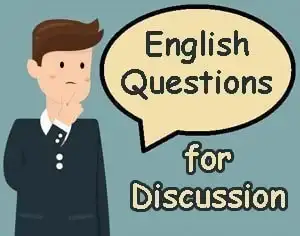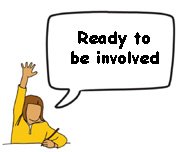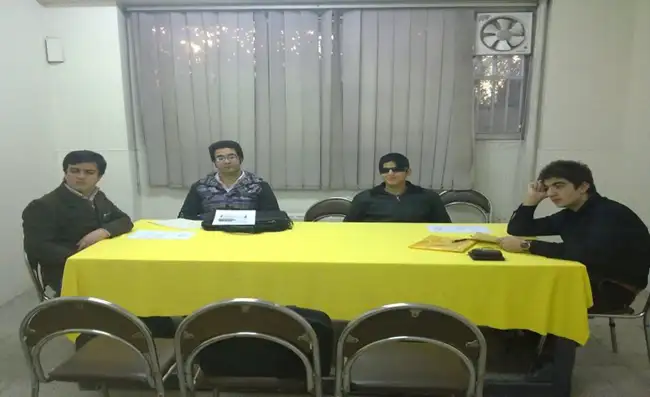Triggering genuine interaction and critical thinking in ESL classes through challenging questions to optimize classroom interaction and social presence among L2 learners
Author: Dr. Mohammad Hossein Hariri Asl
Video of genuine interaction in ESL classes
Abstract
These days, insufficient attention is being paid to the significance of proper questions, the patterns according to which they are to be posed, and the kind of feedback in response to them. Accordingly, some major problems such as: student passivity, teacher-centeredness, and rote-learning come into being. To collect and analyze the data for this study, the researcher, as the direct interviewer and participatory observer, conducted a truly qualitative research (a case-study), in which the data were meticulously and cyclically triangulated from 3 different sources: close observation with checklists, unstructured interviews under the title of round tables, and documentations based on the participants’ compositions within 2 months and a half in a special language institute for the blind. The close analysis of the data made it clear that correct types of questions that are properly implemented positively accounts for negotiation of meaning and form and yields genuine communication. It’s also quite useful in raising the level of consciousness in L2 learners and making them more critical thinkers. Furthermore, proper questions can facilitate SLA by making L2 classes more natural and stress-free.
Background
Thompson (1997) believes, “One of the main forms of interaction between the language teacher and the learner is through questions” (p. 99). Studies of teachers’ questions in the L2 classroom have focused on the frequency of the different types of questions, wait-time (the length of time the teacher is prepared to wait for an answer), the nature of the learners’ output when answering questions, the effect of the learners’ level of proficiency on questioning, the possibility of training teachers to ask more communicative questions, and the variation evident in teacher’ questioning strategies (Ellis, 2008). “Much of the research has been informed by the assumption that L2 learning will be enhanced if the questions result in active learner participation and meaning negotiation” (Ellis, 2008, p. 798).

Lantolf and Genung (2002, as cited in Lantolf, 2006) observed that one student reported engaging in language-focused private speech only after classroom activities shifted from pattern drills and memorization of prepared responses to open-ended and more conversational interaction between teacher and students.
According to Chastain (1988), “Questions and answers (Q and A) form a high percentage of classroom activities that are supposed to get the learners involved in creation or re-creation of meaning through language” (p. 142).
Statement of the problem
In today’s education in the field of SLA, little, if not any, attention is being paid to the way questions are formulated and posed. Even if it happens, it is more theoretical than practical. That’s why, L2 learners are either marginalized or frustrated in L2 classes because they fail to achieve the optimal level of classroom participation.

Regarding this issue from another perspective, whenever the concept of posing questions is raised, we always expect the L2 teacher to be the only questioner. Yet, in actuality, according to a learner-centered pedagogy, the old version of IRF, in which the teacher is the initiator in posing questions has long been violated.
In response to the above-mentioned issues, this study was carried out to seek reasonable answers to the following questions:
- Which types of questions are more helpful in encouraging the participants to think more critically?
- Is there any significant relationship between critical thinking and the selection of questions?
- What changes are made to the students’ rapport in the atmosphere of the classroom if question posing is correctly implemented?
- How can appropriate questions account for negotiation of form and meaning?
Discourse management

One of the most effective ways of managing discourse is to ensure that the topic of the conversation is understood (Ellis, 2008). The need for discourse repair arises when some kind of problem occurs. Two different kinds of problems can be identified: (1) communicative problems and (2) linguistic problems (Ellis, 2008).
Frequently, the two coincide, particularly when the source of the problem lies in something the non-native speaker has said. Discourse repair also occurs even when there is no communication difficulty. In such cases, the problem is purely linguistic in nature. Such repairs are uncommon in conversational interaction but very common in classroom contexts.
Wh-Questions

Cross-linguistic studies on the acquisition of wh-questions have shown that both L1 and L2 learners produce wh-questions in the sequential order of where, what > how, who > why > when (this indicates that where and what are acquired before how and who, which is acquired before why, etc.) (cf. Wode, 1974; Felix, 1976; Labov & Labov, 1978; Lightbown, 1978; Bloom et al., 1982; Stromswold, 1988; Clancy, 1989; Stromswold, 1992, as cited in Park, 2000).
Initiation-Response Feedback (IRF)
According to Cullen (2002), a particular aspect of ‘teacher talk’ is the teacher’s provision of feedback or follow-up’ in classroom discourse. In this response, the ‘F-move’ refers to ‘Follow-up’ or ‘Feedback Move’ identified by Sinclair and Coulthard (1975, as cited in Cullen, 2002) in their new well-known analysis of classroom discourse, as the third move in the IRF exchange structure, standing for ‘initiation-response-feedback’.
One of the most frequent classroom interaction structures between the teacher and students is initiation-response-feedback (IRF). Cook (2008) defines IRF in this way:
- Initiation: The teacher takes the initiative by requiring something of the students.
- Response: Next, the student does whatever is required.
- Feedback: The teacher does not go straight on to the next initiation but announces whether the student is right or wrong (pp. 156-157).
According to McCarthy (1991), when IRF happens, pupils will have the chance to practice only a very impoverished range of utterance functions. In much language classrooms, learners rarely get the opportunity to take other than the responding role, and even in cases, where students are encouraged to initiate, the follow-up move is often still in the hands of the teacher, and learners get little or no practice in this particular discourse function.

According to Rivers (1981), the teacher should always ask the question first, then name the student for the individual response; this induces all the students to think about the answer while waiting to see if they will be asked the question. However, it is important to note that a student who answers a question sincerely should never be made to feel stupid or ignorant.
When a student has given a wrong answer, the teacher should put the same question to another student and, on receipt of the correct answer, put the question again to the student who made the mistake. According to Rivers (1981), an alternative to this procedure is to ask the class to repeat the correct answer in chorus.
Bright students may be asked more difficult questions, invited to help others in group work, or encouraged to do extra, more demanding work on an individual basis. Slow students must not be humiliated or embarrassed if they are working to the best of their ability (Rivers, 1981). According to Rivers (1981), “their deficiencies will not be very obvious to the other students in group work in the early stages or in the laboratory” (p. 490).
Asking good questions
Merriam (1998) believes that interviewing is a proper way to pose questions. An obvious place to begin is by making certain that what is being asked is clear to the person being interviewed. Questions need to be understood in familiar language. “Using words that make sense to the interviewee, words that reflect the respondent’s world view, will improve the quality of data obtained during the interview.

Without sensitivity to the impact of particular words on the person being interviewed, the answer may make no sense at all—or there may be no answer” (Patton, 1990, p. 312, as cited in Merriam, 1998). Avoiding technical jargons and terms and concepts from your particular disciplinary orientation is a good place to begin.
To be effective, questions and answers should be designed to ask for information. That means in every Q and A activity there must be a communicative purpose and an information gap to be filled (Talebinezahd, 1999). Questions that do not serve that purpose will be of little value in language teaching since in reality questions are not asked in vacuums.
Talebinezahd (1999) has offered some general tips on forming proper classroom questions:
- Always have a purpose for your questions, other than testing the student’s knowledge of form.
- Ask for information you do not share with your learners, but make sure they have it, because you do not want to be confined to clichés.
- Try to contextualize your questions and make them as learning based as possible.
- Do not let questions and answers become only one-way activities: questions from teachers and answers from students.
Different types of questions
Different types of questions will yield different information. The questions you ask depend upon the focus of your study (Merriam, 1998). Strauss, Schatzman, Bucher and Sabshin (1981, as cited in Merriam, 1998) offer a list of four major categories of questions: hypothetical, devil’s advocate, ideal position, and interpretive questions.
- Hypothetical questions ask respondents to speculate as to what something might be like or what someone might do in a particular situation. Hypothetical questions begin with “What if” or “Suppose.” Responses are usually descriptions of the person’s actual experience.
- Devil’s advocate questions are particularly good to use when the topic is controversial and you want respondents’ opinions and feelings. This type of question also avoids embarrassing or antagonizing respondents if they happen to be sensitive about the issue. The wording begins, “Some people would say,” which in effect depersonalizes the issue. The response, however, is almost always the respondent’s personal opinion or feeling about the matter.
- Ideal position questions elicit both information and opinion; there can be used with virtually any phenomenon under study. They are good to use in evaluation studies because they reveal both the positives and the negatives or shortcomings of a program.
- Interpretive questions provide a check on what you think you are understanding, as well as provide an opportunity for more information, opinions, and feelings to be revealed.
Barnes (1969, 1976, as cited in Ellis, 2008) distinguished four types of questions he observed in secondary school classrooms in Britain: (1) factual questions (‘what?’), (2) reasoning questions (‘how?’ and ‘why?’), (3) open questions that do not require any reasoning, and (4) social questions (questions that influence student behaviour by means of control or appeal).

Long and Sato (1984, as cited in Ellis, 2008) divide questions into two types. The key distinction was between echoic questions, which ask for the repetition of an utterance or confirmation that it has been properly understood, and epistemic questions, which serve the purpose of acquiring information. The latter type include ‘referential and display questions’. Referential questions are genuinely information-seeking, while display questions test the learner by eliciting already known information. Referential questions are likely to be open, while display questions are likely to be closed.
Another categorization of questions has been offered by Thompson (1997):
- Form: The first dimension that we aim to elicit relates to the grammatical form of the question: whether it is of a yes/no type or the wh-type.
- Content: The second dimension refers to the content of the question: whether it asks about outside facts, personal facts, or opinions.
- Purpose: This dimension forms the third dimension. It relates to the purpose of the question: whether it is for display or communication.
Methodology
To conduct the study, a qualitative mode of research was put to use in the form of ‘case study’. The rationale for employing a case study in this research lies in what Duff (2008) believes about it:
Case studies have a number of characteristics that make them attractive. When done well, they have a high degree of completeness, depth of analysis, and readability. In addition, the cases may generate new hypotheses, models, and understandings about the nature of language learning or other processes. Such knowledge generation is possible by capitalizing on either unique or typical cases in theorizing about particular phenomena that challenge current beliefs. In addition, longitudinal case study research helps to confirm stages or transformations proposed on the basis of larger studies and provides developmental evidence that can otherwise only be inferred (p. 43).
Participants
The participants were among the language learners at the CEC Institute (Communication Expansion Centre), which was a special language institute for the blind and visually impaired people. This sample provided 20 participants for the researcher. They were categorized according to the elementary and intermediate proficiency level. To establish more intimacy and reduce the level of anxiety, the participants were called on with their first names.
The participants were closely studied for a lengthy and uninterrupted period of time equaling two months and a half, including 10 weeks and 20 sessions. The investigator used a ‘purposeful sampling’ to select the participants. According to Best and Kahn (2006), purposeful sampling is rarely used in quantitative research, in which randomness is the preferred technique. In qualitative research, however, the researcher wishes to study a particular sample of persons or documents because of the sample’s usefulness. The researcher is thus aimed at explaining a phenomenon rather than making a generalisation.
Design
The researcher as the initiator of interaction in the classroom made great use of the ‘F-move’ or IRF (initiation-response-feedback’ technique. In so doing, he took a selective approach, that is, he would place the learners in a state of suspense by posing challenging and thought-provoking questions. Then they were given enough time to think about them and give proper answers. A great deal of the questions were communicative and not linguistic in nature.
The researcher’s preferred question types
- Hypothetical Questions (What if?)
- Devil’s Advocate Questions (Some people believe that…)
- Interpretive Questions:
- Reasoning questions (How & Why?)
- Open Questions
- Social Questions: (About social behaviours)
- Referential questions, which are open, meaning-based and not solely on the basis of forms (Talebinezahd, 1999)
- Inferential questions
- Ambiguous and Challenging Questions
- Wh-questions
Round Tables

In this type of activity, the participants were given plenty of time to speculate on challenging topics for the next session. They used to change their chairs and sit at a round table for a ‘hot talk’ on thought-provoking topics, such as ‘Do you like to be smart or cute?’, ‘Do you prefer childhood or adulthood?’, ‘If you were in your teacher’s shoes, what would you do, and what wouldn’t you do?’, ‘Do you like sunset or sunrise, and why?’, and the like.
To select challenging ideas, the researcher referred to the book “The Book of Questions”, which is a great collection of thought-provoking and argumentative questions.
All of the ‘round table’ sessions were recorded and then, analyzed by the investigator. On some occasions, he transcribed the sessions to achieve a deeper understanding of the elicitation or clarification of the information and ideas.
As a matter of fact, the round table sessions functioned as ‘unstructured interviews’ in which, according to Gass and Mackey (2005), no list of questions was used. Instead, the interviewer developed and adapted his own questions, helping respondents to open up and express themselves in their own terms and at their own speed.
Gass and Mackey (2005) maintain, “Unstructured interviews are more similar to natural conversations, and the outcomes are not limited by the researcher’s preconceived ideas about the area of interest” (p. 173). Of course, sometimes, the researcher made great use of semi-structured interviews in which he, from time to time, referred to a list of questions with special classifications when the topic was so complicated.
Discussion and Results
In this part of the enquiry, the collected data are cyclically analyzed in great depth and in a narrative and qualitative mode.
Negotiation of meaning
Throughout the study, it became clear that posing questions is a pretty effective activity to elicit information, establish rapport among the students and the teacher, exchange ideas, and get involved in genuine communication.
In so doing, providing the students with lots of examples and illustrations can have a positive effect to get the meaning across and avoid misunderstandings. But this is not enough. When the learners get a good grip of the discussed issue, it is their turn to provide the teacher and their peers with clear examples. In so doing, negotiation of meaning turns out to be a perfect vehicle through which questions are posed and answered as clearly as possible in a mutual and bilateral atmosphere with lots of give-and-take.

As a request for clarification, whenever it was thought that the participants misunderstood some points, the researcher used to ask them some interpretive questions. For instance, when a learner was trying to distinguish between ‘wealth’ and ‘knowledge’, he was asked:
What is the definition of wealth?
It was because of the fact that, at first, he had a wrong idea of wealth. However, after answer the question with the researcher’s assistance, he changed his idea in making a distinction between ‘wealth’ and ‘knowledge’.
For the sake of simplicity, the conductor of the study had to give so many examples to illustrate questioned phenomena. In this response, he did his best to offer tangible questions. Sometimes, he asked more competent students to give examples. For instance, he once asked Elaheh, a competent student, to give an example of a knowledgeable person in Iran by asking her:
Elaheh, can you give us an example of a knowledgeable person in Iran?
And she correctly responded “Avicenna”.
Furthermore, to naturalize and neutralize the process of posing questions and receiving responses, the investigator tried to teach some idioms and expressions in English in relation to the topic being discussed. The following is a list of some idioms about the topic of wealth or knowledge:
- Money doesn’t grow on trees.
- Money talks.
- Time is money.
- To have a silver spoon in one’s mouth.
- Put your money where your mouth is.
- A little knowledge is a dangerous thing.
The participants liked this activity so much that on some occasions, they would ask me if I know any idiom or expression about other topics. It shows that when the learners are actively and eagerly involved in class activities, they voluntarily ask many questions, too.
It was noticed that the ambience of the classroom plays a significant role on the learners’ level of self-confidence and risk-taking. To be more exact, the more the atmosphere is stress-free and nonjudgmental, the more the learners want to have active and responsive participation. To do so, for example, the learners were called on with their first names. Also they were not criticized for asking questions that were either ungrammatical or wrongly semantic. The result was that even the most reserved and/or incompetent learners would volunteer to answer some questions or pose their own ones, by saying:
Shall I answer this question?
Teacher’s control over discourse

The more democratic and humanistic the process of question positing is, the more the learners will develop a tendency to participate in the discussions. One of the ways to achieve this goal is a modified version of the (IRF Model). To be more precise, in this study, on many occasions, the participants themselves were the initiators, that is, they posed some questions and both the teacher (researcher) and the other participants responded to them.
One of the elements that influenced the process of posing questions was the participants’ level of proficiency. That is to say, the researcher, who was thoroughly familiar with his students, used to choose simpler questions for the less competent learners, and more difficult questions for those who were more competent and proficient.
Active participation
When the participants are given this chance to initiate a discussion, they develop a great tendency to optimize their activeness and participation, and this trait is transmitted to all of the members in the class, even the most introverted ones.
Fortunately, the number of the participants did not exceed 15 in each ‘round table’ session. As a result, each learner had the chance to take part in the conversations, which were full of questions.
It was noticed that, at first, on account of lack of proficiency in English, the participants tended to give short answers to the questions. In this case, the researcher used to ask the same participants some ‘reasoning’ questions, in response to which the learners could give yes/no or short answers. To illustrate this point, the following short dialogue between the researcher and one of the participants has been transcribed:
Researcher: OK, Majid, you said that you preferred intelligence to appearance. Is that right?
Majid: Yes, it is.
Researcher: Good. Now let us know why you prefer intelligence to appearance?
Majid: Because I think intelligence is more useful these days.
Raising consciousness
Active participation requires a great deal of attention and consciousness on the part of the L2 learners. This research made it clear that posing questions randomly makes the learners be alert all the time. In contrast, when the process of posing questions is on the basis of a pre-determined cycle, the learners may try to estimate their actual turns, paying little, if no, attention to the rest of the questions.
On the other hand, when the learners know that each question that is posed could be addressed to them, too, they always try their best to be “quick on trigger”. To achieve this goal, in accordance with IRF, first, it’s better to pose questions, and then, call on the learners to respond to them. This is exactly what happened in the round table activity.
Also it was attempted to pose the same question in different forms so that the learners could distinguish the same meaning in different forms.
Critical thinking

According to Browne and Keeley (2007):
Critical thinking is initially a process of reaction. Someone has strung together a conclusion and some reasons that allegedly make the case for the conclusion. Our task is to decide whether the argument is one we wish to make our own. So any reasoning provides raw material for critical-thinking practice (p. ix).
It became clear that when the participants are asked challenging, multifaceted and thought-provoking questions, particularly indirect and inferential questions, and they are encouraged to provide rationale for their positions in response to the questions, they develop critical thinking together with reasoning and argumentation.
For instance, in response to students whose proficiency level was categorized according to elementary or intermediate, the researcher used to repeat the learners’ statements and then pose questions, as:
Hossein, you said that you prefer ‘wealth’ to ‘knowledge’. Why do you think so?
The employment of reasoning, hypothetical, and devil’s advocate questions is an effective technique to encourage the learners to think critically. In so doing, during the ‘round table’ sessions, some questions such as the following were posed:
If you are asked to choose between childhood and adulthood, which one do you prefer?
What is good about adulthood?
In order to encourage the learners to think critically, there was always a negotiation between the teacher and the learners on the topic of discussion for the following session. He used to pose the following question for this purpose:
Which topic do you prefer for the following session?
In addition, when the learners are given enough time to give thought to the specified topics, they can perform better in answering the questions. Furthermore, for elementary and intermediate students, this extra amount of time can build a great amount of self-confidence.
It is important to mention that in this study, the participants were first required to compose an essay on the specified topics as one of the part of their weekly assignments. Then they were required to get ready for the weekly discussion at the round table.
The positive influence of challenging questions on the students’ critical thinking was so huge that at the end of the study, they used to bombard the investigator with lots of challenging questions, a phenomenon that never existed at the outset of the study. For instance, when we had a conversation at the ‘round table’ on “childhood or adulthood”, one of the participants, Elaheh, asked me:
Do you think that childhood and adulthood are interrelated?
Cooperation and peer work

On many occasions, the learners were required to pose questions, particularly, when their peers were giving lectures, as a part of the curriculum, they were supposed to listen to the auditory text very carefully. After the lecture, the other participants used to ask the lecturers some questions, especially ‘wh-questions’ to elicit information. In fact, the employment of ‘wh-questions’ is a pretty effective technique, particularly for elementary and intermediate learners.
From time to time, the learners used to challenge the researcher by asking about his own idea about the predetermined topics. Of course, this is the result of the promising atmosphere of the classroom and the learners’ optimal level of consciousness.
Conclusion
In the light of this study, it was clarified that asking good questions in a correct format is one of the best techniques to account for negotiation of meaning and form. This is because of the fact that, in so doing, genuine communication in the classroom is accounted for to elicit and clarify information.

Yet, it is really important to determine the type of the questions the teacher poses. In this response, hypothetical, devil’s advocate, reasoning, open, and inferential in the form or paraphrasing are among the best types of questions to account for critical thinking because the learners cannot simply give yes/no or short answers. Instead, they are supposed to offer rationale in support of their claims. As a matter of fact, challenging and thought-provoking questions can raise the level of criticality in the learners.
In addition, proper use of questions can raise the students’ level of consciousness and attention; and therefore, active participation and responsiveness in response to the questions, and also through ‘focus on form’, in which students’ attention is drawn to both form and function.
Finally, posing questions and answering them between the teacher and the learners or among the learners themselves require them to work with each other in a democratic, open-minded and intellectual mode, which is on the foundation of a lot of give-and-take. As a result, cooperative learning and humanistic education are fairly operationalized.
References
- Best, J. W., & Kahn, J. V. (2006). Research in education. Boston, MA: Pearson Education Inc.
- Browne, M. N., & Keeley, S. M. (2007). Asking the right questions: A guide to critical thinking (8th Ed.). New Jersey: Pearson Prentice Hall.
- Chastain, K. (1988). Developing second-language skills: Theory and practice. Orlando, Florida: Harcourt Brace Jovanovich, Inc.
- Cook, V. (2008). Second language learning and second language teaching. London: Hodder Education, Inc.
- Cullen, R. (2002). Supportive teacher talk: The importance of the F-move. ELT Journal, 56(2), 117-127. doi:10.1093/elt/56.2.117
- Duff, P. A. (2008). Case study research in applied linguistics. New York, NY: Lawrence Erlbaum Association, Taylor and Francis Group.
- Ellis, R. (2008). The study of second language acquisition. Oxford: Oxford University Press.
- Gass, S. M. & Mackey, A. (2005). Second language research: Methodology and design. Mahvah, New Jersey, MN: Lawrence Erlbaum Associates, Inc.
- Lantolf, J. P. (2006). Sociocultural theory and L2: State of the art. SSLA, 28, 67–109. doi:10.10170S0272263106060037
- McCarthy, M. (1991). Discourse analysis for language teachers. Cambridge: Cambridge University Press.
- Merriam, S. B. (1998). Qualitative research and case study applications in education. San Francisco, California, SC: Jossey-Bass Inc.
- Park, H. (2000). When-questions in second language acquisition. Second Language Research, 16(1), 44-76. doi:10.1191/026765800666268444
- Rivers, W. M. (1981). Teaching foreign-language skills. Chicago: The University of Chicago Press, Ltd.
- Stock, G. (1987). The book of questions. New York: Workman Publishers.
- Talebinezahd, M. R. (1999). Effective questions. Forum, 37(2).
- Thompson, G. (1997). Training teachers to ask questions. ELT Journal, 51(2), 99-105. doi:10.1093/elt/51.2.99
How to cite this article in APA Style?
Hariri Asl, M. H. (2023). Genuine interaction in ESL classes through questions. LELB Society, https://lelb.net/genuine-interaction-esl-classes-questions/



We respond to all comments immediately. View the 30 newest comments and new topics in forums.